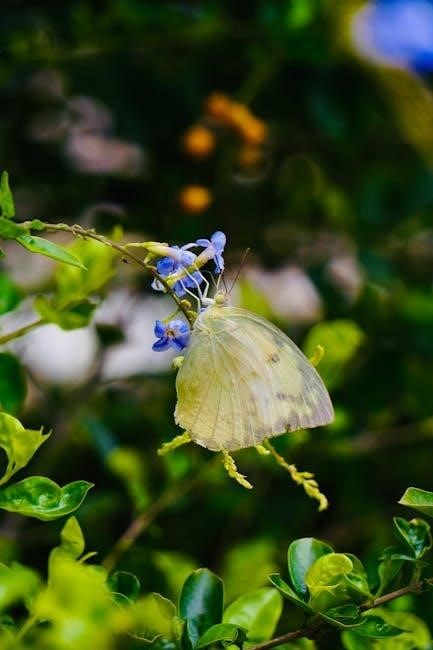John Keats’ Ode to a Nightingale, composed under a plum tree in 1819, explores themes of transience and beauty. Its manuscript returns to its origin, symbolizing enduring artistic legacy, with PDF versions available for scholarly study.
1.1 Overview of the Poem
John Keats’ Ode to a Nightingale is a lyrical masterpiece exploring themes of beauty, mortality, and the transcendent power of art. Composed in 1819 under a plum tree, the poem captures the poet’s longing to escape human suffering through the nightingale’s eternal song. Its manuscript, now returning to its origin, symbolizes the enduring legacy of Keats’ work. The poem’s structure and imagery reflect Romantic ideals, while its deep emotional resonance continues to inspire readers. PDF versions of the poem are widely available, offering scholars and enthusiasts easy access to study its aesthetic and emotional depth, ensuring its relevance in modern literary discourse.
1.2 Historical Context of the Poem
Ode to a Nightingale was written by John Keats in 1819, a period marked by personal loss and existential contemplation. Keats composed the poem in the garden of Spaniards Inn, Hampstead, or under a plum tree at his friend Charles Armitage Brown’s home. This era was pivotal for Keats, as he grappled with the death of his brother Tom and his own failing health. The poem reflects the Romantic era’s fascination with nature, beauty, and mortality. The nightingale’s song, a symbol of transient beauty, resonated deeply with Keats’ emotional state. The historical context underscores the poem’s exploration of escape from suffering through art and nature, themes that remain timeless in literary discourse.
1.3 Significance of the Nightingale in Literature
The nightingale holds a revered place in literature, symbolizing beauty, transcendence, and the human longing for the eternal. In Keats’ Ode to a Nightingale, the bird represents an idealized world of art and nature, contrasting with human suffering. Its song embodies the power of imagination to transcend mortality, a theme central to Romantic poetry. Across literary traditions, the nightingale has been a metaphor for poetic inspiration and the sublime. Keats’ portrayal elevates the nightingale to an icon of enduring beauty, linking it to broader existential questions about life, death, and the search for meaning. Its significance extends beyond the poem, influencing later writers and cementing its place in cultural and literary history.

Themes and Symbolism in “Ode to a Nightingale”

The poem explores mortality, transience, and the eternal beauty of art. The nightingale symbolizes transcendence, contrasting fleeting human suffering with the timelessness of nature and creative expression.
2.1 The Theme of Mortality and Transience
Keats masterfully weaves the theme of mortality and transience throughout the poem. The speaker’s longing to escape life’s pain reflects a deep awareness of human impermanence. The nightingale’s song, symbolizing eternal beauty, contrasts sharply with the transient nature of human existence. Keats uses vivid imagery, such as “hemlock” and “dull opiate,” to convey the desire to transcend suffering through death or oblivion. This theme is central to the Romantic era’s preoccupation with the fleeting nature of life and the enduring power of art. The poem’s exploration of these ideas continues to resonate, offering a profound meditation on existence and the human condition.
2.2 The Symbolism of the Nightingale
The nightingale in Keats’ poem embodies transcendence and immortality, serving as an escape from human suffering. Its song symbolizes eternal beauty and freedom, contrasting with the speaker’s mortal pain. The bird’s voice transcends time, offering solace and a longing for the infinite. Keats uses the nightingale to explore the idea of art as a means to escape life’s transience. The nightingale’s elusive presence mirrors the fleeting nature of beauty, while its song endures, becoming a symbol of the timeless power of art. This duality underscores the poem’s exploration of the human condition, where the nightingale represents both the unattainable and the eternal.
2.3 The Contrast Between Eternal Beauty and Human Suffering
Keats’ Ode to a Nightingale vividly juxtaposes the timelessness of beauty with the anguish of human existence. The nightingale’s song, a symbol of eternal beauty, contrasts sharply with the speaker’s mortal suffering. The poem explores the transience of life and the longing to escape pain, while the nightingale’s melody endures, untouched by time. This duality highlights the human condition’s frailty and the universal desire to transcend it. The nightingale’s song becomes a metaphor for art’s power to immortalize beauty, offering solace amidst life’s fleeting nature. This contrast underscores the poem’s profound meditation on mortality, beauty, and the enduring appeal of artistic expression.

Structure and Style of the Poem
Keats’ Ode to a Nightingale features a rich, lyrical structure with vivid imagery and sensory details. The poem’s flow captures the nightingale’s song, blending beauty with melancholy, while its style emphasizes emotional depth and philosophical reflection.
3.1 The Use of Imagery and Sensory Details
Keats masterfully employs imagery and sensory details in Ode to a Nightingale, crafting vivid scenes that immerse the reader in a world of beauty and melancholy. The poem’s opening lines, “My heart aches, and a drowsy numbness pains,” evoke a deep emotional and physical sensation, drawing the reader into Keats’ introspective state. The nightingale’s song is portrayed as a transcendent force, with imagery that appeals to the auditory sense, while references to nature—like the “moon” and “vine”—engages the visual and tactile imaginations. Sensory details such as “hemlock” and “dull opiate” further enhance the poem’s emotional depth, creating a rich tapestry of experiences that resonate profoundly with the reader.
3.2 The Role of Nature in the Poem
Nature plays a central role in Ode to a Nightingale, serving as both a source of inspiration and a backdrop for Keats’ exploration of human emotions. The nightingale, a symbol of natural beauty and transcendence, embodies the carefree and eternal aspects of nature, contrasting sharply with the poet’s own mortal suffering. The poem’s setting, whether under a plum tree or in the garden of Spaniards Inn, emphasizes nature’s ability to evoke profound feelings of wonder and melancholy. Through vivid descriptions of the natural world, Keats uses nature to reflect on themes of mortality, longing, and the fleeting nature of life, creating a poignant interplay between the external environment and internal emotional landscapes;
3.3 The Poetic Devices Used by Keats
Keats masterfully employs poetic devices to elevate Ode to a Nightingale, crafting a rich and evocative experience. Imagery and sensory details, such as the “drowsy numbness” and “hemlock,” immerse readers in the poet’s emotional landscape. Similes and metaphors, like comparing the senses to opiate effects, enhance the depth of feeling. Alliteration and assonance create a melodic flow, mirroring the nightingale’s song. Personification of the nightingale as an immortal being underscores its timeless beauty. Enjambment and caesura add rhythm, reflecting the fluid yet fragmented nature of human thought. These devices collectively amplify the poem’s emotional resonance, making it a masterpiece of Romantic-era poetry.

PDF Versions of “Ode to a Nightingale”
Open Library offers free PDF downloads of Ode to a Nightingale, allowing readers to access Keats’ timeless masterpiece digitally. Password protection options are also available.
4.1 Sources for Downloading the PDF
Open Library is a reliable platform for downloading Ode to a Nightingale in PDF format. With over 1 million eBooks, it provides free access to Keats’ masterpiece. Additionally, Google Books and Project Gutenberg offer digital versions of the poem, ensuring accessibility for scholars and enthusiasts alike. These platforms are trusted sources for high-quality, downloadable content. When downloading, ensure to use reputable websites to avoid low-quality scans or malicious files. Open Library, in particular, is recommended for its vast collection and user-friendly interface; These resources make it easy to obtain and study Keats’ timeless work digitally.
4.2 How to Access the PDF for Free

To access the PDF of Ode to a Nightingale for free, visit Open Library or Google Books. Search for the poem by title or author, and select the desired version. Some platforms may require creating an account or signing in. Once logged in, look for the download option, often labeled as “PDF” or “Download.” Ensure the file is free by checking for labels like “Free eBook” or “Public Domain.” After downloading, the PDF can be saved to your device for reading or printing. These platforms provide high-quality, freely accessible versions of Keats’ work, making it easy to explore the poem digitally without cost.
4.3 Protecting and Managing the PDF File
To protect and manage your Ode to a Nightingale PDF, consider password-protecting the file using software like Adobe Acrobat. This prevents unauthorized access and ensures the file’s integrity. Organize the PDF in a dedicated folder on your device or cloud storage for easy access and backup. Regularly back up the file to avoid loss due to device malfunctions. Additionally, use reputable PDF readers or editors to avoid accidental edits or corruption. By taking these steps, you can securely manage and preserve your digital copy of Keats’ timeless poem for future reference and enjoyment.

Scholarly Perspectives on the Poem
Scholars analyze Ode to a Nightingale for its exploration of mortality and beauty. Experts like Ahmed T. Hussein highlight its profound examination of human longing and transience.
5.1 Critical Analysis of the Poem’s Aesthetics
Keats’ Ode to a Nightingale captivates with its rich imagery and sensual language, creating a vivid experience. Scholars praise its exploration of transience and beauty, offering deep insights into human longing. The poem’s aesthetic appeal lies in its ability to evoke emotions through nature, making it a timeless work. Available in PDF, it remains a focal point for literary analysis, allowing readers to delve into its profound themes and lyrical beauty.
5.2 Comparative Study with Other Works
Ode to a Nightingale is often compared to other Romantic-era poems, such as Percy Bysshe Shelley’s Ode to the West Wind, for its exploration of transience and beauty. Scholars highlight Keats’ unique sensory language, distinguishing it from Shelley’s more political tones. Additionally, the poem is juxtaposed with W.H. Auden’s works, particularly in its thematic focus on mortality. PDF analyses reveal how Keats’ emotional depth contrasts with Auden’s intellectual approach. These comparisons underscore Keats’ ability to blend personal longing with universal themes, setting Ode to a Nightingale apart in Romantic literature. Available in PDF, such studies offer insightful perspectives on Keats’ place within literary history.
5.3 The Poem’s Place in Romantic Poetry
Ode to a Nightingale holds a central position in Romantic poetry, embodying key themes of the era such as the pursuit of beauty, mortality, and the transcendental power of imagination. Composed in 1819, the poem reflects Keats’ profound emotional depth and his unique ability to weave sensory language into philosophical inquiry; It stands alongside works by Wordsworth and Coleridge as a cornerstone of Romantic literature, celebrating nature’s beauty while confronting human suffering. The poem’s exploration of transience and eternal art resonates deeply, solidifying its legacy. PDF versions of the poem, widely available, continue to inspire scholars and readers, ensuring its enduring relevance in Romantic studies and beyond.

The Poem’s Cultural and Historical Legacy
The manuscript of Ode to a Nightingale is returning to its origin, marking 200 years since its creation. Its themes of beauty and mortality continue to inspire writers and artists, while its representation in art and media underscores its timeless appeal. The poem’s PDF versions remain a vital resource for scholars, ensuring its relevance in modern times and solidifying its place as a cornerstone of Romantic literature.
6.1 The Poem’s Impact on Later Writers
John Keats’ Ode to a Nightingale has profoundly influenced later writers, inspiring works that explore themes of beauty and transience. Its emotional depth and vivid imagery have shaped Romantic poetry, with poets like Wystan Hugh Auden drawing parallels in their exploration of death’s aesthetics. The poem’s manuscript, returning to its original setting, symbolizes its enduring legacy. PDF versions of the poem, widely accessible, continue to inspire modern authors, ensuring Keats’ masterpiece remains a cornerstone of literary influence, bridging the past and present in its exploration of human longing and the ephemeral nature of life. Its impact resonates across generations.
6.2 The Poem’s Representation in Art and Media
Keats’ Ode to a Nightingale has inspired numerous artistic interpretations, transcending literature into music, film, and visual arts. Its themes of beauty and transience resonate deeply, with composers creating works inspired by its emotional resonance. The poem’s imagery has also influenced filmmakers, who often use its motifs to evoke a sense of longing and ephemeral beauty. Additionally, visual artists have captured the nightingale’s symbolism in paintings, reflecting the poem’s enduring influence. The availability of the poem in PDF formats has further facilitated its adaptation, allowing modern creators to draw inspiration from its timeless themes and aesthetic depth, ensuring its presence in contemporary art and media.
6.3 The Poem’s Relevance in Modern Times
Despite being written two centuries ago, Ode to a Nightingale remains remarkably relevant today, offering insights into universal themes such as existential longing and the pursuit of transcendence. Modern readers connect with Keats’ exploration of mortality, beauty, and the human condition, resonating across cultural and temporal boundaries. The poem’s focus on escapism and the fleeting nature of life continues to captivate audiences, making it a timeless classic. Its availability in PDF formats ensures accessibility, allowing contemporary readers to engage with its profound reflections. The poem’s enduring appeal lies in its ability to evoke emotions and thoughts that remain central to human experience, solidifying its place in modern literary discourse and personal reflection.

Resources for Further Reading
Open Library offers free Ode to a Nightingale PDFs and eBooks. ResearchGate and Google Scholar provide scholarly articles and in-depth analyses for further exploration;
7.1 Recommended Books and Articles
For deeper insights, The Cambridge Companion to Keats offers comprehensive analysis of his works, including Ode to a Nightingale. Peer-reviewed articles on JSTOR and Google Scholar provide scholarly perspectives. Additionally, John Keats: A Literary Life by Nicholas Roe explores the poet’s creative process. These resources enrich understanding of the poem’s themes and historical context, making them essential for academic research and personal study. They complement the PDF versions of the poem, offering a well-rounded exploration of Keats’ masterpiece.
7.2 Online Platforms for Scholarly Research

For in-depth scholarly research on Ode to a Nightingale, platforms like JSTOR, ResearchGate, and Google Scholar provide extensive resources. JSTOR offers access to academic journals and articles, while ResearchGate allows researchers to share and discover new studies. Google Scholar is a valuable tool for finding free PDFs of scholarly articles and books. Additionally, university libraries often provide access to these platforms, ensuring a wealth of information for students and researchers. These platforms are essential for exploring critical analyses, historical contexts, and interpretations of Keats’ work, making them indispensable for academic and personal study.
7.3 Open Library and Other Digital Archives
Open Library and other digital archives are invaluable resources for accessing Ode to a Nightingale in PDF format. Open Library, with its vast collection of over 1 million eBooks, offers free access to Keats’ works, including scholarly editions and critical analyses. Other platforms, such as Project Gutenberg and ManyBooks, also provide digitized versions of the poem and related essays. These archives ensure that literary treasures remain accessible to researchers and enthusiasts worldwide. By preserving and sharing these works, they contribute to the ongoing study and appreciation of Romantic poetry, making them essential tools for both academic and personal exploration of Keats’ enduring legacy.
John Keats’ Ode to a Nightingale remains a timeless masterpiece, blending themes of mortality, beauty, and escape. Its enduring legacy, now accessible via PDFs, invites continued exploration and admiration.
8.1 Summary of Key Points
Ode to a Nightingale is a profound exploration of human emotions, mortality, and the transcendent power of art. The poem, written by John Keats in 1819, delves into the speaker’s longing to escape life’s sorrows through the nightingale’s eternal song. Themes of transience, beauty, and the allure of death are central, while the nightingale symbolizes immutable artistry and bliss. PDF versions of the poem are widely available, preserving its legacy for modern readers. The manuscript’s return to its origin underscores its historical and cultural significance, inviting scholars and enthusiasts alike to engage with Keats’ masterpiece anew.
8.2 Final Thoughts on the Poem’s Significance
Ode to a Nightingale remains a timeless masterpiece of Romantic poetry, offering insights into the human condition and the enduring power of art. Its exploration of mortality, beauty, and transcendence continues to resonate with readers. The poem’s return to its origins highlights its lasting cultural impact, while PDF versions ensure accessibility for future generations. Keats’ work transcends time, serving as a testament to the universal themes of longing and the pursuit of eternal beauty. Its significance lies in its ability to evoke profound emotions and inspire reflection, solidifying its place as a cornerstone of literary heritage.
8.3 Encouragement for Further Exploration
Exploring Ode to a Nightingale offers a rich journey into Romantic poetry and its cultural significance. The poem’s themes of beauty, mortality, and transcendence invite readers to delve deeper. PDF versions provide convenient access for analysis, allowing scholars and enthusiasts alike to uncover its layers. Cross-referencing with scholarly articles and comparative studies enhances understanding, while digital archives like Open Library offer free resources. Engaging with the poem’s legacy through art and media further enriches its appreciation. Embrace the opportunity to explore this timeless work, fostering a deeper connection with Keats’ vision and its enduring impact on literature and culture.